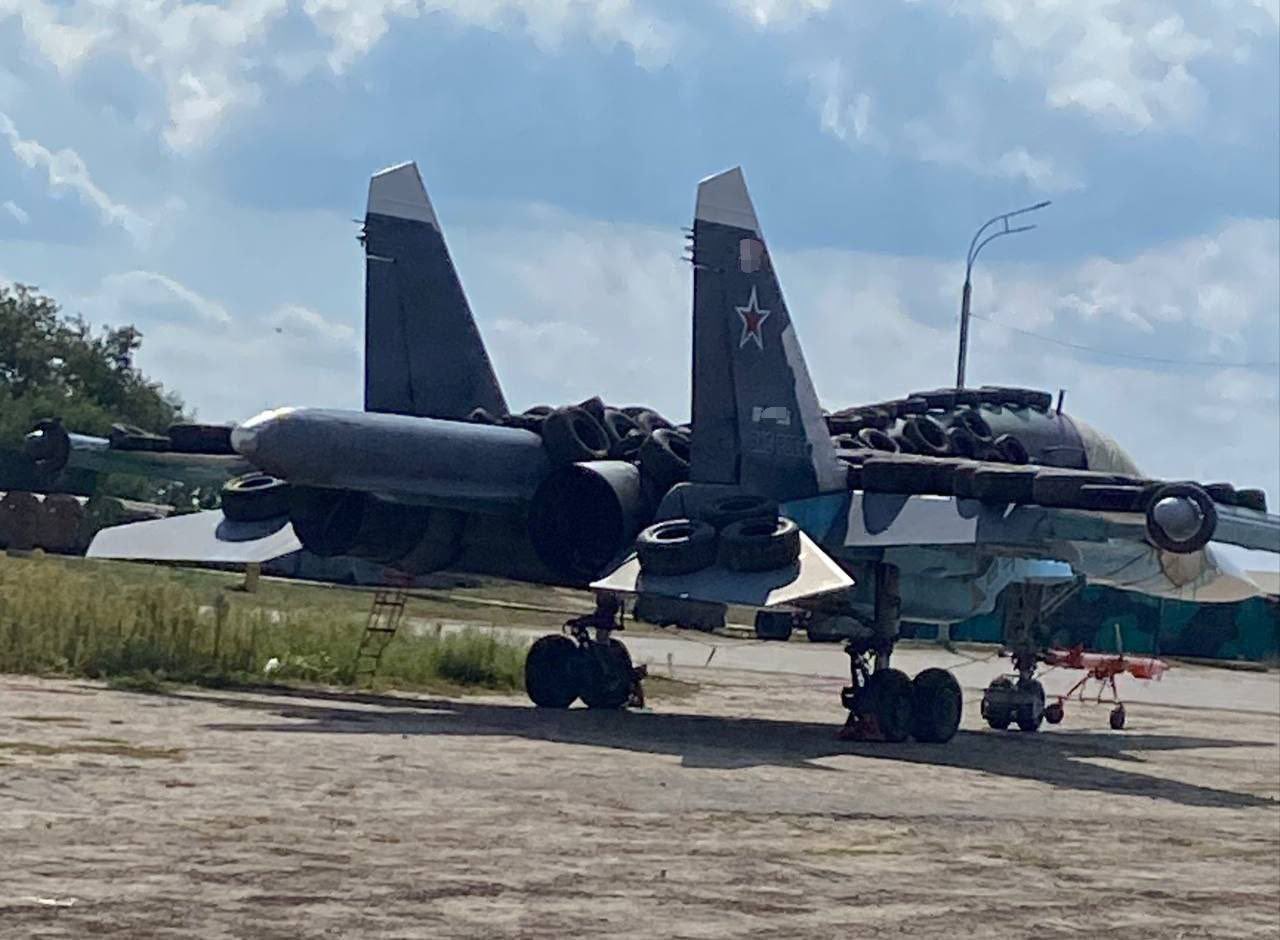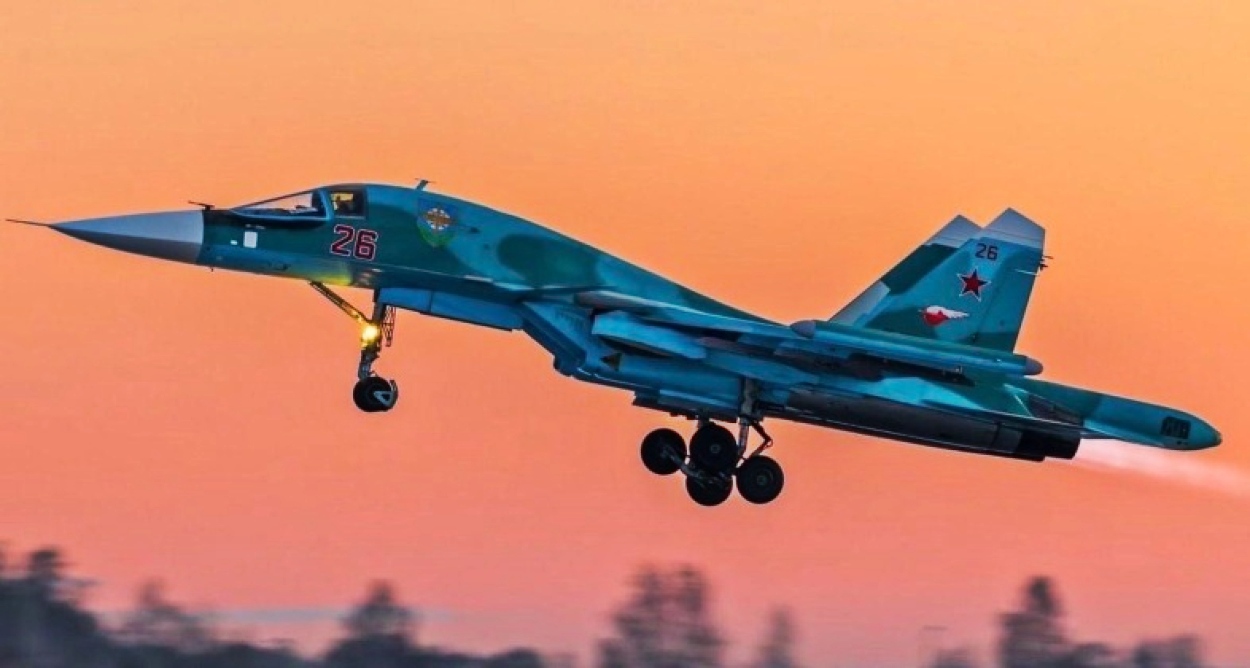Following the online circulation of satellite pictures showing Russian bombers covered in tires, a new image depicting a Sukhoi Su-34 Fullback bomber adorned with tires has now surfaced.
The photograph of the Su-34 aircraft began to circulate widely on September 8, capturing the attention of aviation enthusiasts and military observers alike. However, the precise date and location of its origin remain unknown.
The image is thought to have been initially shared by the Fighterbomber Telegram channel, which has connections to the Russian Aerospace Forces, and subsequently circulated on X, formerly known as Twitter.
In the image, a Fullback aircraft can be observed, with wheels positioned on the upper surface of its fuselage, extending to the cockpit glass. Notably, the presence of tires is not limited to the fuselage alone; they can also be observed hanging from the aircraft’s wingtip electronic warfare pods.
The aircraft is stationed on the ramp, lacking armaments, and a tarp shields its canopy. Thus, we cannot dismiss the possibility that the plane might not be operational.

Based on satellite imagery, EurAsian Times recently reported that the Russian military appeared to have positioned surplus car tires on the wings and fuselage of their Cold War-era Tupolev strategic bombers at the Engels airfield.
The Fighterbomber Telegram channel has indicated that using tires on the Fullback and other Russian aircraft reflects a growing trend borne out of necessity to safeguard these aircraft when suitable shelters are unavailable.
Describing the situation, Fighterbomber stated, “In general, a campaign across the country began. This is not all from a good life, and apparently, this is the only option to do something quickly and without extortion from personnel.”
Furthermore, the Telegram channel urged Russia to immediately launch an initiative, funded by the public, to construct lightweight shelters or canopies for combat-ready tactical aircraft at airfields located near Ukraine.
However, Fighterbomber did not explicitly explain the purpose behind placing tires on the Fullback displayed in the picture it shared.
Possible Reason Behind Russia’s Adoption of This Approach
Several theories are circulating regarding this apparent defensive tactic, mainly as it appears to be adopted by an increasing number of aircraft within the Russian Air Force.
This approach comes in response to drone strikes that have targeted Russian air bases, resulting in significant losses of military aircraft for the country. This signals a substantial change in the conflict dynamics, with Kyiv actively working to erode domestic Russian support for the war.
The specific commencement date of Russia’s use of tires as protective measures for its air assets remains somewhat elusive, yet it appears to correlate with the onset of aerial strikes.
Ukrainian sources have suggested that tires are being used as an improvised defense against kamikaze drone attacks, while alternative theories propose that the tires may serve as counterweights.
In contrast to the situation with the Tu-95s, where the engine’s absence was visible in satellite imagery, the current circumstances make it challenging to ascertain the absence of major components.

There are indications that the Su-34 might be lacking a portion of its righthand side engine nozzle, and there is even a possibility of the entire engine being missing. However, these observations cannot be definitively confirmed due to the low quality of the available photos.
It is plausible that the Su-34 is undergoing an extended maintenance period or encountering other technological challenges that could explain the observed discrepancies.
Expressing an opinion on the matter, a former US Naval officer who preferred to remain anonymous shared with EurAsian Times, “The effectiveness of this approach seems rather uncertain to me. However, those tires can disrupt space-based synthetic aperture radar (SAR) surveillance, critical for all-weather targeting, even in adverse conditions like cloud cover, both day and night.”
He highlighted that when examining the signal reflections captured through Synthetic Aperture Radar (SAR), it becomes evident that they do not align with the aircraft’s anticipated geometry and material composition.
This observation could indicate the potential adoption of new camouflage methods to protect these valuable aircraft from drone attacks.
The presence of the tires may also pose challenges for munitions equipped with radar-seeking guidance systems. However, as of now, there is no knowledge of Ukrainian standoff munitions utilizing this particular concept of terminal guidance.
Nonetheless, Russia has demonstrated its readiness to deploy straightforward countermeasures against such systems.
Yet, several experts have argued that while it might seem like the tires could protect against drone attacks, they have many vulnerabilities. They don’t provide solid protection and can catch fire easily, making them a danger to the aircraft.
- Contact the author at ashishmichel(at)gmail.com
- Follow EurAsian Times on Google News




